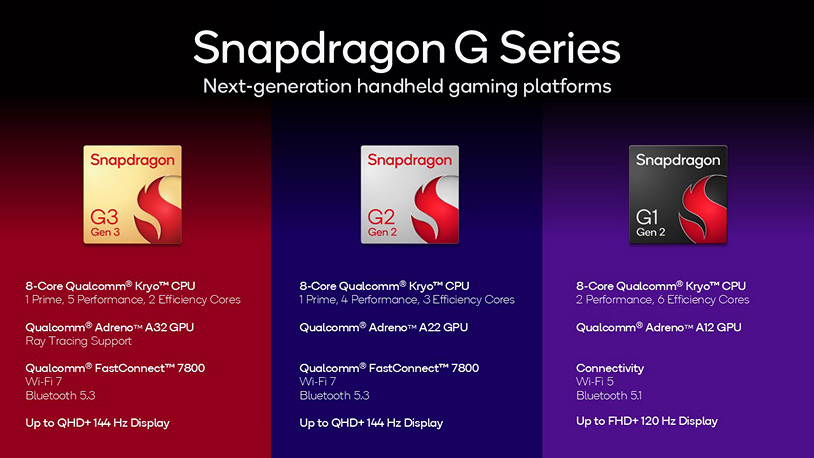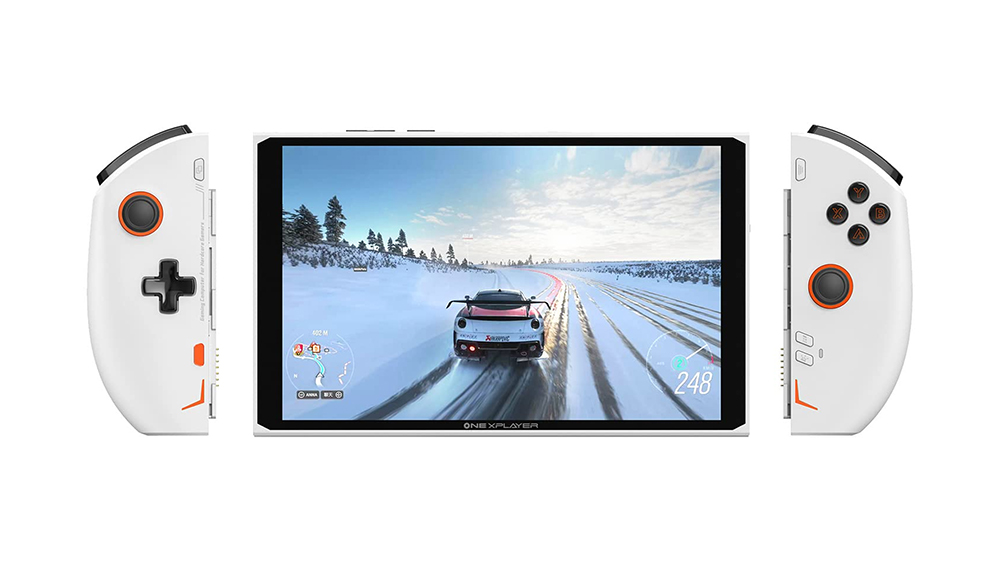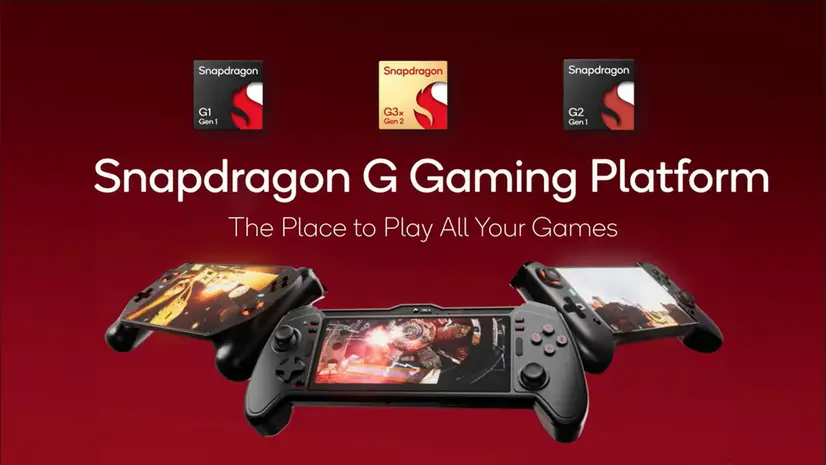Qualcomm's Snapdragon G Series: A New Challenger in Handheld Gaming
20 May 2025 · News · Marcus Wilson
// Three New Chips Target Everything from Budget to Premium Gaming Handhelds
The handheld gaming market has experienced remarkable growth since Valve's Steam Deck proved that portable PC gaming could work beyond Nintendo's domain. With an estimated 6 million handheld gaming PCs shipped globally through 2024, this emerging category has attracted attention from major chipmakers. Qualcomm's latest move into this space represents perhaps the most significant challenge yet to AMD's dominance in portable gaming processors.
The company has unveiled three new processors specifically designed for handheld gaming devices: the Snapdragon G3 Gen 3, G2 Gen 2, and G1 Gen 2. These chips mark Qualcomm's most serious attempt to establish ARM-based alternatives to the x86 processors that currently power devices like the Steam Deck, ASUS ROG Ally, and Lenovo Legion Go.
The New Snapdragon G Lineup Explained
Qualcomm's refreshed G series covers three distinct market segments, each targeting different price points and performance expectations. The flagship Snapdragon G3 Gen 3 leads the charge with substantial improvements over its predecessor, whilst the G2 Gen 2 and G1 Gen 2 provide more accessible entry points into ARM-powered handheld gaming.
The G3 Gen 3 features an octa-core Kryo CPU configuration with one Prime core, five Performance cores, and two Efficiency cores. Perhaps more significantly, it includes the new Adreno A32 GPU with hardware ray tracing support---a first for Qualcomm's gaming-focused processors. The company claims 30% faster CPU performance and 28% improved GPU performance compared to the previous generation.

One notable advancement is the G3 Gen 3's support for Unreal Engine 5's Lumen lighting system, marking Qualcomm's entry into more sophisticated graphics rendering previously reserved for desktop and console gaming. The processor can drive displays up to QHD+ resolution at 144Hz, representing a significant step up from the previous generation's FHD+ limitation.
Performance Claims and Real-World Expectations
Qualcomm's performance figures paint an optimistic picture, but the handheld gaming market has taught us to approach such claims with measured expectations. The G2 Gen 2 supposedly delivers 2.3 times better CPU performance and 3.8 times improved GPU performance compared to its predecessor, whilst the entry-level G1 Gen 2 promises 80% faster CPU performance and 25% better graphics.
These improvements, if accurate, would represent substantial generational leaps. However, the fundamental challenge remains whether ARM-based processors can deliver gaming experiences that match or exceed current x86 solutions from AMD. The Steam Deck's custom AMD APU has set a high bar for handheld gaming performance, particularly when combined with Valve's optimised SteamOS.
The inclusion of ray tracing capabilities in the G3 Gen 3 demonstrates Qualcomm's ambition to compete with high-end gaming features. However, mobile ray tracing has historically struggled with power efficiency---a critical concern for battery-powered devices where thermal management and battery life often determine usability more than peak performance.
Early Adopters and Device Partners
Several established handheld gaming manufacturers have committed to using Qualcomm's new processors. Ayaneo, a prominent player in the premium handheld space, plans to release multiple devices powered by the G3 Gen 3, including the Pocket S2 and Gaming Pad. OneXPlayer, another well-known brand, will incorporate the chip into their upcoming OneXSugar device.
Retroid Pocket, which has gained popularity for affordable emulation-focused handhelds, represents perhaps the most interesting partnership. Their upcoming devices will use both the G2 Gen 2 and G1 Gen 2 processors, potentially bringing ARM-powered gaming to more budget-conscious consumers.

The Retroid Pocket Classic, powered by the G1 Gen 2, stands out for its aggressive pricing strategy. Starting at £99 for the base configuration, it aims to demonstrate that ARM-based handheld gaming can compete on cost whilst delivering acceptable performance for retro gaming and less demanding titles.
The ARM vs x86 Gaming Debate
Qualcomm's entry into handheld gaming raises fundamental questions about processor architecture choices. Current market leaders like the Steam Deck, ROG Ally, and Legion Go all use x86 processors, primarily AMD's custom APUs, which offer broad compatibility with existing PC game libraries.
ARM processors typically excel in power efficiency and thermal management---crucial advantages for handheld devices. However, they face significant software compatibility challenges. Most PC games are compiled for x86 architecture, requiring translation layers or native ARM ports to run properly on Snapdragon-powered devices.
The success of Apple's M-series processors in laptops demonstrates ARM's potential for high-performance computing, but gaming compatibility remains inconsistent even on Apple Silicon. For Qualcomm's G-series to succeed in handheld gaming, manufacturers will likely focus on Android gaming ecosystems and emulation scenarios where ARM compatibility is less problematic.
Market Timing and Competitive Landscape
Qualcomm's aggressive push into handheld gaming comes at an interesting time for the market. Recent research indicates that handheld PC sales declined by approximately 50% in 2024 compared to 2023, suggesting the initial enthusiasm may be cooling. With total market volume estimated at under 2 million units for 2025, the question becomes whether there's sufficient demand to support another major architecture.
The timing may actually work in Qualcomm's favour. As the initial wave of x86 handhelds matures, consumers are becoming more aware of their limitations: mediocre battery life, thermal throttling, and the complexity of running Windows on small touchscreens. ARM processors could address many of these pain points whilst offering manufacturers more flexibility in device design.

However, Qualcomm faces the challenge of convincing both manufacturers and consumers that ARM-based gaming can deliver comparable experiences to established x86 solutions. The company's mobile gaming credentials are strong, but translating that success to dedicated gaming handhelds requires proving performance capabilities and building software ecosystems that match user expectations.
Software Ecosystem Challenges
Perhaps the biggest hurdle facing Qualcomm's handheld gaming ambitions lies in software compatibility and ecosystem development. Whilst Android gaming has matured significantly, the expectation for handheld gaming PCs extends beyond mobile games to include console emulation and PC gaming libraries.
Emulation represents the most promising application for ARM-based handhelds. Many popular emulators already support ARM architecture, and the power efficiency advantages could enable longer gaming sessions for retro gaming enthusiasts. This explains why partners like Retroid Pocket are focusing on emulation-centric devices.
For broader PC gaming compatibility, Qualcomm-powered devices would likely need to rely on cloud gaming services or streaming solutions. This approach could work well given the processors' strong connectivity features, but it requires reliable internet connections and introduces latency concerns that don't affect local gaming.
Future Implications for Handheld Gaming
Qualcomm's entry into handheld gaming represents more than just new processor options---it signals a potential shift towards more diverse hardware approaches in portable gaming. If ARM-based handhelds can deliver compelling gaming experiences whilst addressing current limitations around battery life and thermal management, they could carve out significant market share.
The success of these processors will largely depend on execution by device manufacturers and the development of compelling software ecosystems. Early devices will need to demonstrate clear advantages over x86 alternatives, whether through superior battery life, better thermal performance, or more attractive pricing.
For consumers, Qualcomm's G-series processors represent another option in an increasingly diverse handheld gaming landscape. Rather than replacing x86 devices entirely, ARM-powered handhelds will likely establish themselves in specific niches---emulation gaming, mobile gaming, and potentially as more affordable entry points into handheld PC gaming.
Looking Ahead
The introduction of Qualcomm's Snapdragon G-series processors marks a significant moment for handheld gaming. Whether these chips can successfully challenge AMD's dominance will depend on real-world performance, software ecosystem development, and manufacturers' ability to create compelling devices that leverage ARM's inherent advantages.
With devices expected to arrive throughout 2025, we'll soon discover whether ARM-based handheld gaming can deliver on its theoretical promises. The stakes are high---success could democratise handheld gaming through better battery life and lower costs, whilst failure might reinforce x86's continued dominance in portable PC gaming.
For now, Qualcomm's bold entry into this competitive market represents exactly the kind of innovation the handheld gaming space needs to continue evolving beyond its current limitations.